Beer Market Size
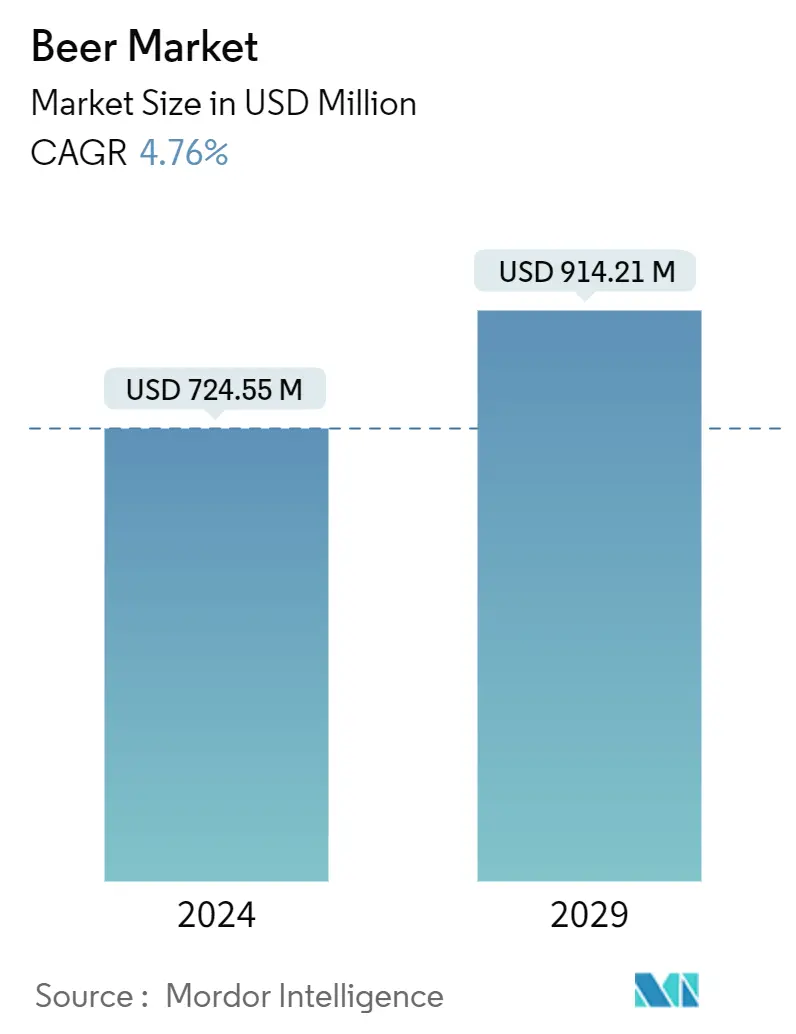
| Study Period | 2019 - 2029 |
| Market Size (2024) | USD 724.55 Million |
| Market Size (2029) | USD 914.21 Million |
| CAGR (2024 - 2029) | 4.76 % |
| Fastest Growing Market | Asia Pacific |
| Largest Market | North America |
Major Players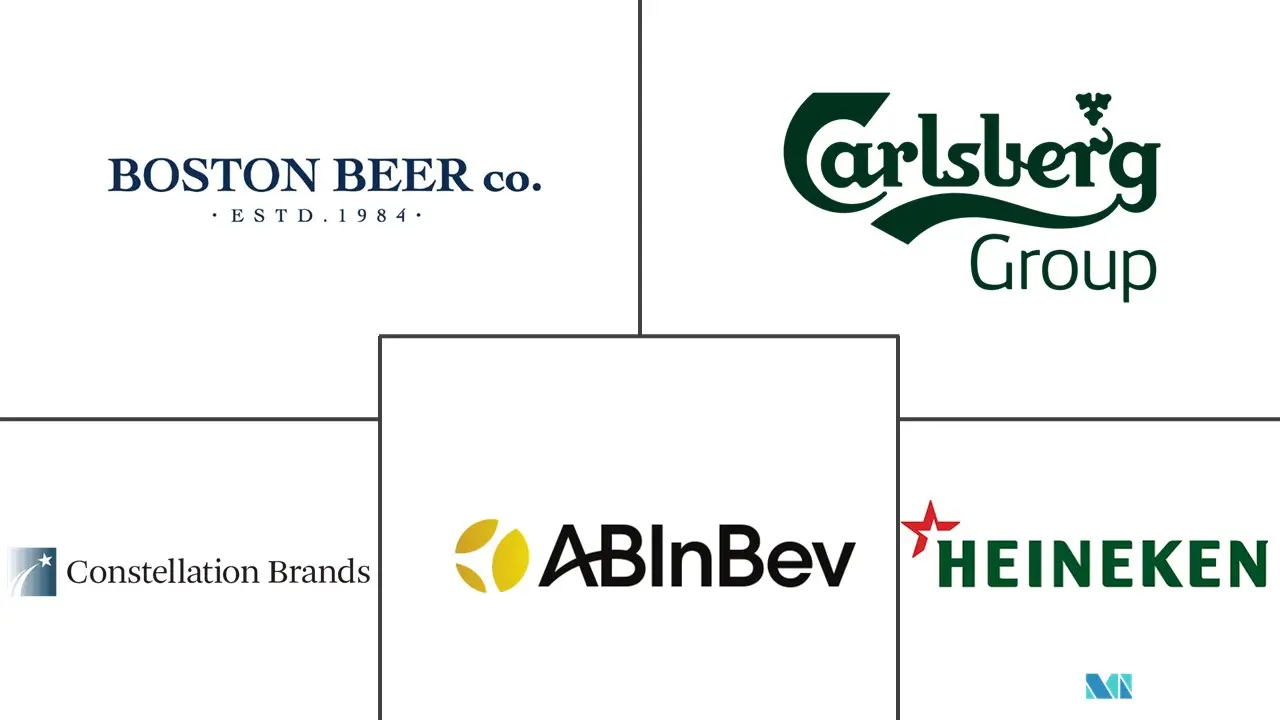
*Disclaimer: Major Players sorted in no particular order |
Beer Market Analysis
The Beer Market size is estimated at USD 724.55 million in 2024, and is expected to reach USD 914.21 million by 2029, growing at a CAGR of 4.76% during the forecast period (2024-2029).
- Beer holds a prominent share in the market for alcoholic beverages. Beer already has significant popularity among millennials and Gen Z due to its diverse formulations and flavor offerings. Over the medium term, changing lifestyles, the increasing consumption rate of alcoholic drinks, rapid urbanization, and high disposable incomes are expected to support the global beer market. Additionally, introducing new ingredients combining fruity and tart flavors in craft beers has increased its appeal among millennials.
- The wide availability of beer brands and products in the market and the continued strength of well-positioned beer companies have been significant positive factors for the beer industry. For instance, as one of the fastest-growing brands in the world, Bira 91 has built a diverse portfolio of beers, one for every occasion, and aims to drive the global shift in beer toward more color and flavor. With such strategies, the brand is focused on offering its products for every occasion to expand its sales.
- Consequently, consumers' inclination toward low alcohol, by volume, has significantly driven the beer market share. The increased health awareness among people and the promoted inclusion of functional and natural ingredients provides more significant opportunities for the premium beer market, leaving beer companies with new opportunities to cater. Therefore, seeking massive potential in the premium category, the leading players operating in the global beer market are tapping into the category.
- For instance, In September 2022, United Breweries Ltd., a part of Amsterdam-based Heineken Group, launched Heineken Silver to expand its portfolio in the premium beer category in India. Natural ingredients such as A-yeast and pure malt are used in brewing Heineken Silver by seasoned master brewers. Such developments, coupled with increasing consumption and inclination towards sophisticated beer options, are expected to support and drive the market growth during the forecast period.
Beer Market Trends
Preference for Low Alcoholic Beer by Volume (ABV) or Non-Alcoholic Beers
- The brewing industry is witnessing an increased demand for low-alcohol-by-volume beverages, specifically among millennials and baby boomers. The sales of low-alcohol drinks have been rising, with consumers’ growing interest in health-consciousness and the availability of a more comprehensive product portfolio with improved taste, aiding consumers to select products per their preference easily.
- Additionally, beer industry statistics state that low-alcohol beers are becoming more popular, owing to increased consumer knowledge of alcohol unit intake and customers' eagerness to sample new beverages. This shift in beer industry trends may be seen in the demand for low-alcohol and no-alcohol drinks by volume in the United Kingdom, United States, Germany, and Canada, where off-license and supermarket sales have been growing rapidly. For instance, according to the Beer Institute organization, the import volume of non-alcoholic beer in the United States amounted to 12.58 million gallons in 2022, which increased from 11.96 million gallons in the previous year.
- The other beer industry trends supporting the brewing industry growth are the launch of new and innovative products. Low-alcohol beers are now cheaper than their high-alcohol equivalents, especially those with 2.8% alcohol by volume (ABV) and lower. The scenario is more prevalent in European countries, like Sweden, where brewers seek to change the low alcohol-by-volume beer by launching attractive products across wide distribution channels to penetrate the market.
- For instance, in March 2023, Carlsberg Marston’s Brewing Company launched Carlsberg 0.0 across the United Kingdom. The company launched this product in over 300 Tesco stores and Tesco online stores. Such factors are expected to aid ABV or non-alcoholic beers further to grow its market during the forecast period.
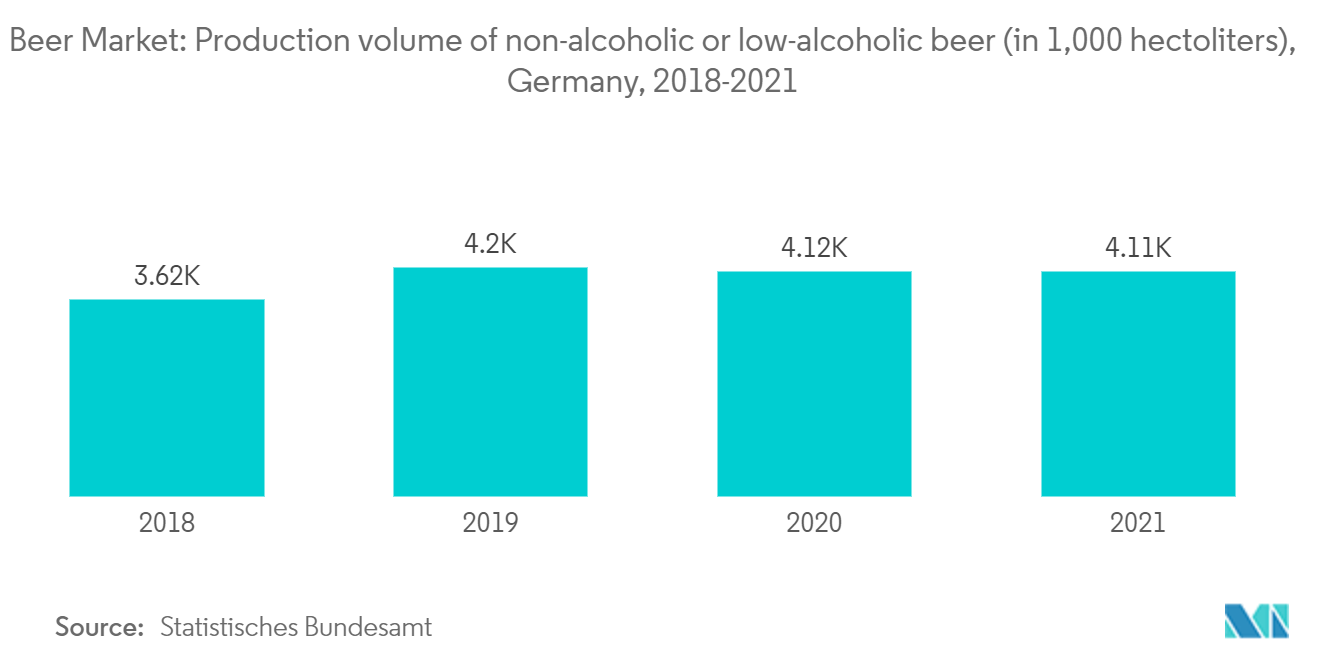
North America Dominates the Market
- The United States is one of the prominent countries in terms of the beer market share due to its high production and consumption rates. For instance, according to the Brewers Association, the United States produced 24.8 million barrels of beer in 2021, with an 8% growth rate. The United States beer market has also contributed to the increasing preference for alcoholic beverages among consumers. Particularly, millennials are more interested in experiencing a variety of flavored beer and beer mixes for innovative drinking experiences.
- On the other hand, the growing number of brewpubs, microbreweries, and taprooms is the primary factor driving the beer market growth in the country. Based on the Brewery Association data, 202 new brewpubs were opened in the country in 2021. Similarly, 360 taprooms opened in the same year.
- Moreover, beer industry analysis shows that beer has become integral to social gatherings, parties, and celebrations in the United States. Furthermore, the increasing number of microbreweries has surged the popularity of craft beer in the country, which was supported by the shifting consumer demand toward variety and taste for flavor that led to the inclusion of microbreweries into the craft beer industry. According to the Brewers Association, the number of craft breweries in the United States reached 9118 in 2021 from 8391 in 2019.
- Furthermore, with the growing craft beer trend, brewers are focused on launching new products to make a significant beer market share by brand. For instance, in March 2021, Stone Cold Steve Austin partnered with El Segundo Brewing to release a new American lager at Billy Bob’s Texas in Forth Worth, featuring a concert by Texas country-rock outfit Reckless Kelly. Such new segments developing in the brewing industry are expected to expand in the region, thereby aiding the beer companies to grow.
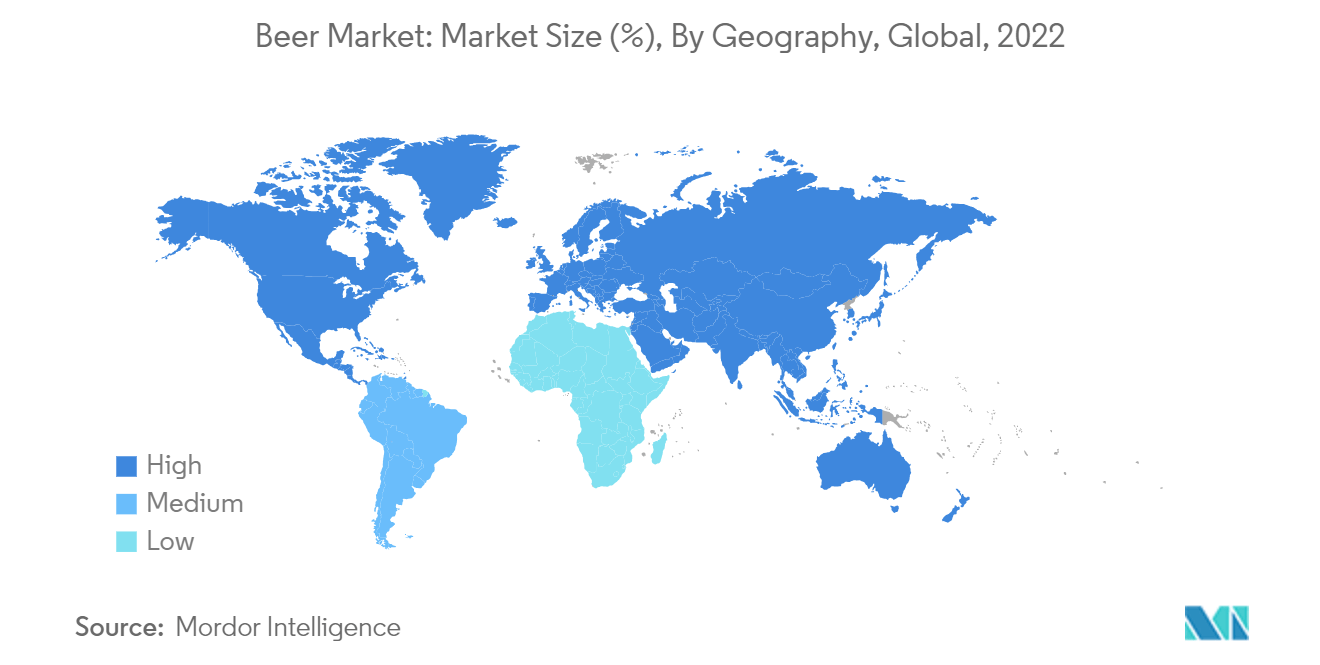
Beer Industry Overview
The global beer market is characterized by major players engaging in expansions and provide flavorful offerings. Companies holding a high beer market share include Anheuser-Busch InBev, Heineken, Boston Beer Company, Constellation Brands, and Carlsberg Group. These companies have been growing over the last few years by expanding their presence in emerging economies. They adopt business strategies such as product innovations, partnerships, marketing campaigns, mergers, and acquisitions to gain a prominent beer market share.
Beer Market Leaders
-
Carlsberg Group
-
Anheuser-Busch InBev
-
Heineken N.V.
-
The Boston Beer Company
-
Constellation Brands
*Disclaimer: Major Players sorted in no particular order
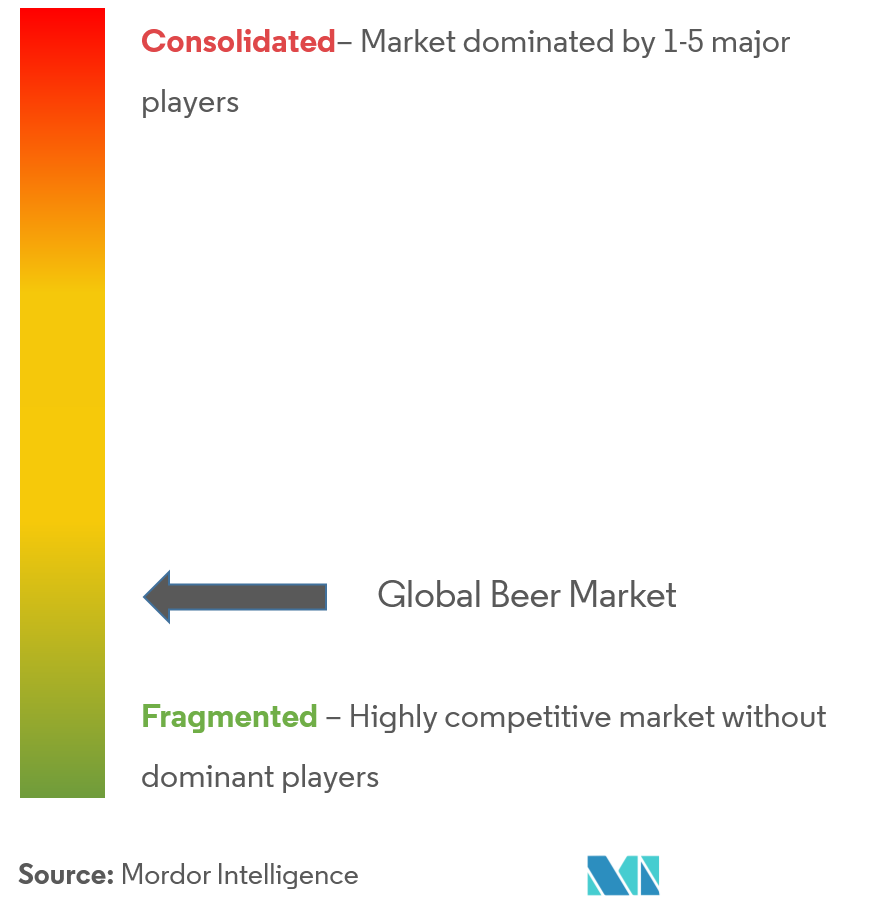
Beer Market News
- October 2022: VictoriaTM unveiled Vicky Chamoy, a Mexican-imported beer infused with chamoy flavors, offering a unique blend of sweet, salty, spicy, and sour notes. This distinctively flavored beer is available in a convenient single-serve 24-ounce can.
- September 2022: Heineken Group's United Breweries launched Heineken Silver, a part of the renowned Amsterdam-based Heineken brand lineup. Brewed by experienced master brewers, Heineken Silver boasts natural ingredients like A-yeast and pure malt for an exceptional taste.
- May 2022: Anheuser-Busch InBev introduced Seven Rivers, a new beer in the Indian market akin to renowned brands like Budweiser, Corona Extra, and Hoegaarden. Initially available in select areas of Karnataka and Maharashtra, it's set to expand its presence to regions including Delhi, Goa, Haryana, and Uttar Pradesh in the near future.
Beer Market Report - Table of Contents
1. INTRODUCTION
- 1.1 Study Assumptions and Market Definition
- 1.2 Scope of the Study
2. RESEARCH METHODOLOGY
3. EXECUTIVE SUMMARY
4. MARKET DYNAMICS
-
4.1 Market Drivers
- 4.1.1 Growing preference for low alcoholic beer by volume (abv) or non-alcoholic beers
- 4.1.2 Rising number of breweries leading to high prominence of craft beer
-
4.2 Market Restraints
- 4.2.1 Demand for other alcoholic beverages
-
4.3 Porter's Five Forces Analysis
- 4.3.1 Threat of New Entrants
- 4.3.2 Bargaining Power of Buyers/Consumers
- 4.3.3 Bargaining Power of Suppliers
- 4.3.4 Threat of Substitute Products
- 4.3.5 Intensity of Competitive Rivalry
5. MARKET SEGMENTATION
-
5.1 By Product Type
- 5.1.1 Lager
- 5.1.2 Ale
- 5.1.3 Other Product Types
-
5.2 By Category
- 5.2.1 Standard Beer
- 5.2.2 Premium Beer
-
5.3 By Distribution Channel
- 5.3.1 On-trade Channels
- 5.3.2 Off-trade Channels
-
5.4 By Geography
- 5.4.1 North America
- 5.4.1.1 United States
- 5.4.1.2 Canada
- 5.4.1.3 Mexico
- 5.4.1.4 Rest of North America
- 5.4.2 Europe
- 5.4.2.1 United Kingdom
- 5.4.2.2 Germany
- 5.4.2.3 Spain
- 5.4.2.4 France
- 5.4.2.5 Italy
- 5.4.2.6 Russia
- 5.4.2.7 Rest of Europe
- 5.4.3 Asia-Pacific
- 5.4.3.1 China
- 5.4.3.2 Japan
- 5.4.3.3 India
- 5.4.3.4 Australia
- 5.4.3.5 Rest of Asia-Pacific
- 5.4.4 South America
- 5.4.4.1 Brazil
- 5.4.4.2 Argentina
- 5.4.4.3 Rest of South America
- 5.4.5 Middle East and Africa
- 5.4.5.1 United Arab Emirates
- 5.4.5.2 South Africa
- 5.4.5.3 Rest of Middle East and Africa
6. COMPETITIVE LANDSCAPE
- 6.1 Most Adopted Strategies
- 6.2 Market Share Analysis
-
6.3 Company Profiles
- 6.3.1 Asahi Group Holdings Ltd
- 6.3.2 Anheuser-Busch InBev
- 6.3.3 Boston Beer Company
- 6.3.4 Breckenridge Brewery
- 6.3.5 Constellation Brands
- 6.3.6 Diageo PLC
- 6.3.7 Heineken NV
- 6.3.8 Interbrew Company
- 6.3.9 SABMiller PLC
- 6.3.10 United Breweries Group (UB Group)
- *List Not Exhaustive
7. MARKET OPPORTUNITIES AND FUTURE TRENDS
** Subject To AvailablityBeer Industry Segmentation
Beer is an alcoholic drink made from yeast-fermented malt and flavored with hops. The beer market is segmented by type, category, distribution channel, and geography.
The global beer market share is segmented based on type into lager, ale, and other product types. The market is segmented into standard and premium beer based on categories and beer market share by brand is also provided. The distribution channel segment of the beer market includes on-trade and off-trade channels. The market is segmented by geography into North America, Europe, Asia-Pacific, South America, and the Middle East and Africa.
For each segment, the beer market size and forecasts have been done based on the value in USD.
| By Product Type | Lager | |
| Ale | ||
| Other Product Types | ||
| By Category | Standard Beer | |
| Premium Beer | ||
| By Distribution Channel | On-trade Channels | |
| Off-trade Channels | ||
| By Geography | North America | United States |
| Canada | ||
| Mexico | ||
| Rest of North America | ||
| By Geography | Europe | United Kingdom |
| Germany | ||
| Spain | ||
| France | ||
| Italy | ||
| Russia | ||
| Rest of Europe | ||
| By Geography | Asia-Pacific | China |
| Japan | ||
| India | ||
| Australia | ||
| Rest of Asia-Pacific | ||
| By Geography | South America | Brazil |
| Argentina | ||
| Rest of South America | ||
| By Geography | Middle East and Africa | United Arab Emirates |
| South Africa | ||
| Rest of Middle East and Africa |
Beer Market Research Faqs
How big is the Beer Market?
The Beer Market size is expected to reach USD 724.55 million in 2024 and grow at a CAGR of 4.76% to reach USD 914.21 million by 2029.
What is the current Beer Market size?
In 2024, the Beer Market size is expected to reach USD 724.55 million.
Who are the key players in Beer Market?
Carlsberg Group, Anheuser-Busch InBev, Heineken N.V., The Boston Beer Company and Constellation Brands are the major companies operating in the Beer Market.
Which is the fastest growing region in Beer Market?
Asia Pacific is estimated to grow at the highest CAGR over the forecast period (2024-2029).
Which region has the biggest share in Beer Market?
In 2024, the North America accounts for the largest market share in Beer Market.
What years does this Beer Market cover, and what was the market size in 2023?
In 2023, the Beer Market size was estimated at USD 690.06 million. The report covers the Beer Market historical market size for years: 2019, 2020, 2021, 2022 and 2023. The report also forecasts the Beer Market size for years: 2024, 2025, 2026, 2027, 2028 and 2029.
What are the key factors driving the Beer Market?
The key factors driving the Beer Market are a) Increasing breweries experimenting with new ingredients, styles, and brewing techniques b) Effective campaigns, brand storytelling foster loyalty and customer engagement
Beer Industry Report
The global beer market is experiencing significant growth, driven by factors such as improving disposable income, rising westernization, and increasing prevalence of alcohol socialization among consumers. The market segmentation includes lager, ale, and other product types, with a notable trend towards premium and super premium categories. The industry analysis highlights the use of glass and metal can packaging as a growing trend. Key market leaders such as Anheuser-Busch InBev, Beijing Enterprises Holdings Limited, and Carlsberg Group are focusing on expanding production and distribution across regions including Asia-Pacific, North America, Europe, and LAMEA.
Market data indicates that the global market is dominated by macrobreweries, which are actively involved in new product launches, expansions, and partnerships to cater to evolving consumer preferences. Despite the market growth, challenges such as restricted provincial acts for marketing and advertising of alcoholic beverages in several regions persist. The market forecast suggests continued growth, with an emphasis on industry trends and market predictions.
The industry outlook and industry size are essential factors for understanding the market value and market overview. Industry statistics and market research provide insights into the market structure and market report details. The market review and market segmentation are crucial for identifying target market segments and understanding market trends.
Industry reports and industry research are vital for keeping up-to-date with industry information and industry sales. The market outlook and market growth are influenced by the growth rate and market forecast. Industry reports and report pdfs offer a comprehensive view of the market, while research companies provide valuable industry insights.
In summary, the global beer market is poised for growth, driven by consumer trends and strategic initiatives by key market players. The market value and market segmentation are critical for understanding the industry's dynamics, and industry analysis provides a detailed overview of market trends and growth opportunities.



